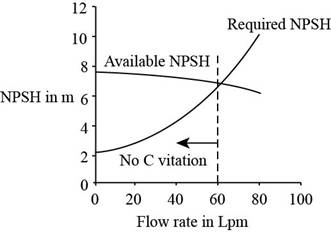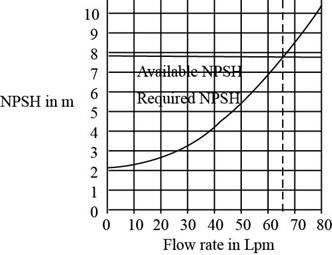
Concept explainers
Repeat Prob. 14-60, but with the pipe diameter increased by a factor of 2 (all else being equal). Does the volume flow rate at which cavitation occurs in the pump increase or decrease with the larger pipe? Discuss.
Whether the volume flow rate at which cavitations occurs in the pump increase or decrease of the larger pipe.
Answer to Problem 62P
The diameter of the pipe is doubled then the flow rate increase by
Explanation of Solution
Given information:
The pipe diameter is increased by the factor two.
Write the expression for the net positive suction head.
Here, the net positive suction head is
Write the expression for the total head loss.
Here, the friction factor is
Write the expression for the average speed.
Here, the diameter of the pipe is
Write the expression for the Reynolds number.
Here, the Reynolds number is
Write the expression for the friction factor.
Substitute
Write the expression for the required net positive suction head.
Here, the required net positive head is
Write the expression for the percentage increase.
Here, the percentage increase is
Calculation:
Refer the Table B-1, "The physical properties of saturated liquid" to obtain the value of the density is
Refer the Table B-1, "The physical properties of saturated liquid" to obtain the value of the kinematic viscosity is
Refer the Table B-1, "The physical properties of saturated liquid" to obtain the value of the vapor pressure is
Substitute
Substitute
Substitute
Substitute
Substitute
Substitute
The following table represents the net positive suction head, the required net positive suction head, and discharge.
| | |
Plot the graph by using tabulated values.

Figure-(1)
From Figure-(1), the cavitations occurs at the flow rate
Substitute
Substitute
Substitute
Substitute
Substitute
Substitute
The following table represents the net positive suction head, the required net positive suction head, and discharge.
| | |
Plot the graph by using tabulated values.

Figure-(2)
From Figure-(2), the cavitations occurs at the flow rate
Substitute
The diameter of the pipe is doubled then the flow rate increase by
Conclusion:
The diameter of the pipe is doubled then the flow rate increase by
Want to see more full solutions like this?
Chapter 14 Solutions
Fluid Mechanics: Fundamentals and Applications
- please include fbd Two vertical tanks, one with circular section 3.0 m in diameter, the other square section 1.33 m x 1.33 m are connected by a short tube ( area is 0.725 sq. cm) near bottom. Initially, the head of oil in the first tank is 4.0 m, while in the second tank the head is 60 cm. After a quick opening of the tube's vlave, find the time for the oil surfaces to equalize. Assume the tube properties to be similar to that orifice, with C= 0.78. a. 21 seconds b. 35 seconds c. 23 seconds d. 26 secondsarrow_forwardinclude a free body diagram Seawater is to be pumped into a large tank at a rate of 165 kg/min. The tank is opwn to atmostsphere and the water enters the tank from a 80 m height. The overall efficiency of the motor pump unit is 75 percent and the motor consumes electricity at a rate of 3.2 KW. If the irreversible headloss in the piping is 7 m, the velocity of the water (in m/s) at the tank inlet isA. 6.21B. 7.12C. 8.7D. 5.05arrow_forwardThe water surface in reservoir B is 12m higher than the surface of reservoir C. A 40-cm diameter, 0.7km long iron-cast pipe carries water at 20°C from B to C. Determine discharge for this pipe? Friction factor for iron-cast pipe, f-0.018. Ke-0.5 and Kd=1.0, where: Ke - entrance coefficient; Kd- discharge coefficient. O A. 0.232m3/sec O B. 360L/sec OC.0.360m3/sec O D.0.336m3/secarrow_forward
- Water at 16oC (Density = 999 kg/m3 ; Viscosity = 1.12 x10 -3 kg/m-s) is flowing steadily in a 50.8-mm diameter horizontal pipe made of commercial steel at a rate of 0.00567 cubic meter per second. The required theoretical pumping power input in watt for flow over a 61-meter long section of the pipe is Blank 1 watt. *Express your answers in whole significant figure without decimal value and without unit*arrow_forwardWrite the equation that defines actual (available) net positive suction head NPSH. From this definition, discuss at least five ways you can decrease the likelihood of cavitation in the pump, for the same liquid, temperature, and volume flow ratearrow_forwardIt can be shown that for fully-developed pipe flow dP/dz is a constant. Derive an expression for this constantarrow_forward
- Water is being pumped from a reservoir to the top of a hill, where it is discharged, as shown in Fig. 20-21. Thepump, which is 70 percent efficient, is rated at 150 kW. Find the flow rate at which water is being dischargedfrom the pipe. Neglect minor losses.arrow_forwardis friction factor inversely proportional to the Reynold’s number in case of laminar flow in circular pipes?arrow_forwardplzzzz help me with this one plzzz Water (viscosity of 0.001 kg/m.s and density of 1000 kg/m3 ) is to be pumped through 50 m of pipe from lower reservoir to a higher reservoir at a rate of 0.2 m3/s. If the pipe is cast iron of diameter 12 cm and the pump efficient is =0.44%, the major head loss inside the pipe is ¼ of the velocity head what horsepower pump is needed? Hint: consider the abrupt expansion only as a minor loss.arrow_forward
- Why are liquids usually transported in circular pipes?arrow_forward(b) Bathroom sinks and some other fixtures include an overflow opening in the basin. This opening is located on the wall and near the top of the basin. The overflow opening serves two important functions: If the water tap is left on while the drain stopper is closed, the opening will channel water down into the drain opening rather than letting is spill out of the sink onto the floor. The overflow allows the sink to drain faster by introducing air into the system. A sink with a dimension given in Figure Q2(b), has water flows into it at a rate of 8 L/min. If the drain stopper is closed and water level in the sink remains constant, determine the average velocity of water flows through the 3.0 cm diameter overflow hole. Front 3 cm diameter overflow holes Q-8 L/min 15 3/4| 40 cm 15 cm Side (a) Figure Q2: (a) Picture of the sink; (b) Sink dimension (Ь)arrow_forwardWater at 10 C flows in a 1.25-cm-diameter pipe at a rate of 1.33 L/min. The hydrodynamic entry length (in meters) isarrow_forward
 Elements Of ElectromagneticsMechanical EngineeringISBN:9780190698614Author:Sadiku, Matthew N. O.Publisher:Oxford University Press
Elements Of ElectromagneticsMechanical EngineeringISBN:9780190698614Author:Sadiku, Matthew N. O.Publisher:Oxford University Press Mechanics of Materials (10th Edition)Mechanical EngineeringISBN:9780134319650Author:Russell C. HibbelerPublisher:PEARSON
Mechanics of Materials (10th Edition)Mechanical EngineeringISBN:9780134319650Author:Russell C. HibbelerPublisher:PEARSON Thermodynamics: An Engineering ApproachMechanical EngineeringISBN:9781259822674Author:Yunus A. Cengel Dr., Michael A. BolesPublisher:McGraw-Hill Education
Thermodynamics: An Engineering ApproachMechanical EngineeringISBN:9781259822674Author:Yunus A. Cengel Dr., Michael A. BolesPublisher:McGraw-Hill Education Control Systems EngineeringMechanical EngineeringISBN:9781118170519Author:Norman S. NisePublisher:WILEY
Control Systems EngineeringMechanical EngineeringISBN:9781118170519Author:Norman S. NisePublisher:WILEY Mechanics of Materials (MindTap Course List)Mechanical EngineeringISBN:9781337093347Author:Barry J. Goodno, James M. GerePublisher:Cengage Learning
Mechanics of Materials (MindTap Course List)Mechanical EngineeringISBN:9781337093347Author:Barry J. Goodno, James M. GerePublisher:Cengage Learning Engineering Mechanics: StaticsMechanical EngineeringISBN:9781118807330Author:James L. Meriam, L. G. Kraige, J. N. BoltonPublisher:WILEY
Engineering Mechanics: StaticsMechanical EngineeringISBN:9781118807330Author:James L. Meriam, L. G. Kraige, J. N. BoltonPublisher:WILEY





